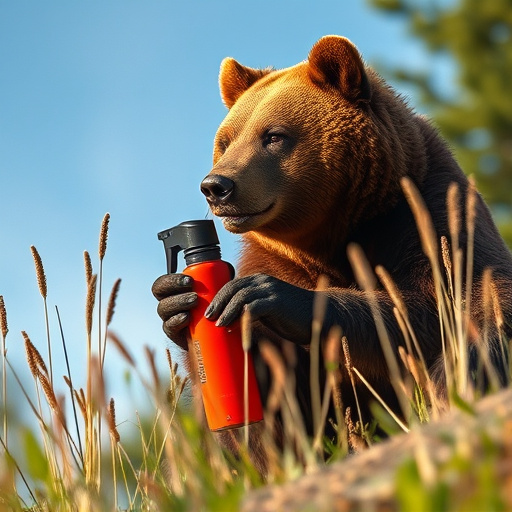Bears' strong sense of smell influences their behavior, making bear spray a vital safety tool for outdoor enthusiasts in bear country. Effectiveness depends on product freshness and specific ingredients like capsaicin, with a typical shelf life of 2-3 years. Regularly checking expiration dates, understanding ingredients (including potential additives), and proper storage are crucial for optimal performance. Additionally, using noise makers, wearing protective clothing, and securing food in bear-resistant containers enhance safety during encounters.
In areas inhabited by aggressive bears, understanding their behavior and having the right tools are crucial for safety. This comprehensive guide explores outdoor protection methods against these formidable predators. We delve into the science behind bear sensing, particularly their acute sense of smell, and how it influences their interactions with humans. Key topics include demystifying bear spray: its composition, expiration dates, and ingredient quality. Additionally, we offer extra safety measures beyond bear spray for a multi-faceted approach to bear encounter preparedness.
- Understanding Bear Behavior and Their Sense of Smell
- What Is Bear Spray and How Does It Work?
- Expire Date and Ingredient Quality: Demystifying Bear Spray Composition
- Additional Safety Measures Beyond Bear Spray
Understanding Bear Behavior and Their Sense of Smell
Bears, particularly aggressive ones, have complex behaviors driven by instincts rooted in their survival and reproductive needs. Understanding these behaviors is crucial for outdoor enthusiasts navigating bear country. One key aspect to grasp is a bear’s acute sense of smell, which can detect food sources from significant distances. This sensory acuity often leads bears to humans as they forage for sustenance, especially when attracted by odors associated with food or improper waste disposal.
Bear spray, a common deterrent, relies on its pungent ingredients to disrupt a bear’s behavior and create an escape route. However, it’s essential to note that bear spray does expire over time, so users must check the product’s freshness before each trip into the wild. The ingredients in bear spray can degrade, reducing their effectiveness, so staying informed about the product’s shelf life and understanding its limitations is vital for anyone aiming to protect themselves from potential bear encounters.
What Is Bear Spray and How Does It Work?
Bear spray, also known as bear repellent, is a crucial tool for outdoor enthusiasts and individuals navigating bear-inhabited areas. It’s a specialized aerosol designed to deter bears when faced with an encounter. The primary active ingredient in bear spray is capsicum, derived from chili peppers. When sprayed towards a bear, the capsaicin irritates the bear’s eyes, nose, and respiratory system, causing it to retreat. This method of protection doesn’t harm the bear but effectively enables humans to create distance during potentially dangerous situations.
Understanding the expiration date and ingredients is essential for effective use. Bear spray typically has a shelf life of around 2-3 years if stored properly. Ingredients other than capsicum may include various oils, water, and preservatives. Always check the label for details on its effectiveness period and specific components to ensure optimal performance when needed.
Expire Date and Ingredient Quality: Demystifying Bear Spray Composition
Bear spray, a crucial tool for outdoor enthusiasts navigating bear country, is not one-size-fits-all. Understanding its composition, including expiration dates and ingredient quality, is essential for effective protection. Bear sprays typically have a shelf life of 2 to 3 years, after which their effectiveness may diminish. This expiration date is often marked on the can, so it’s crucial to check before heading out into the wilderness.
The ingredients in bear spray play a vital role in its performance. Active ingredients like capsaicin, the substance that gives chili peppers their heat, and various pyrethroids are common. These components deter bears by irritating their eyes and olfactory receptors. High-quality ingredients ensure the spray delivers on its promise during encounters. Using expired or low-quality bear spray might not provide adequate protection, leaving you vulnerable to aggressive bear behavior.
Additional Safety Measures Beyond Bear Spray
While bear spray is an essential tool for deterring aggressive bears, it’s not the only measure you should take to ensure your safety when venturing into bear country. Understanding the shelf life and ingredients of bear spray is crucial; check expiration dates regularly as the effectiveness of the spray decreases over time. Typically, bear spray can last up to 3 years if stored properly, but the active ingredients degrade naturally, reducing its potency.
In addition to regular inspections of your gear, consider carrying other safety items like a loud whistle, which can startle bears and give you time to escape. Wearing thick clothing and carrying food securely in bear-resistant containers are also effective strategies. Knowing how to make noise while navigating through dense forests or high-risk areas can significantly reduce the risk of an unexpected encounter.
Understanding bear behavior, the power of their sense of smell, and the effectiveness of bear spray is key to your safety in bear country. When choosing bear spray, consider the expiration date and ingredient quality to ensure its potency. Beyond bear spray, additional safety measures like making noise, traveling in groups, and securing food properly are crucial. By combining these strategies, you can minimize risks and enjoy outdoor adventures with enhanced peace of mind.
